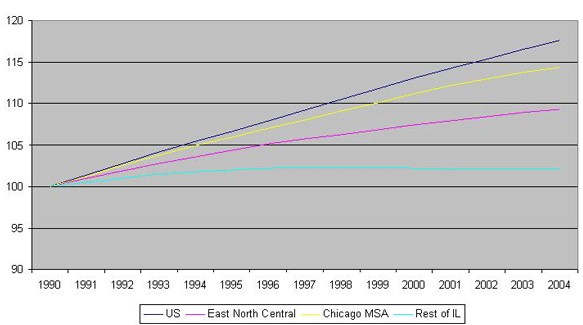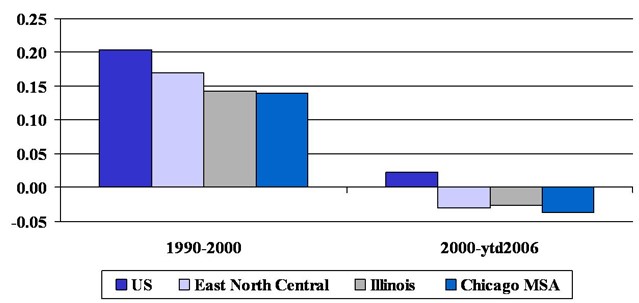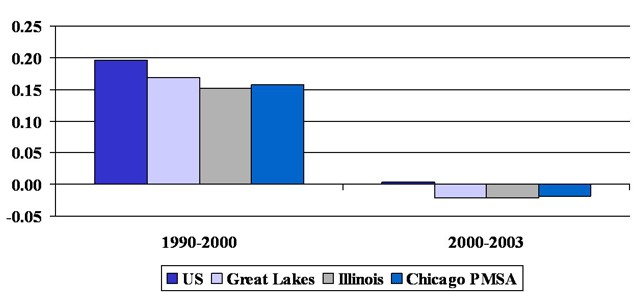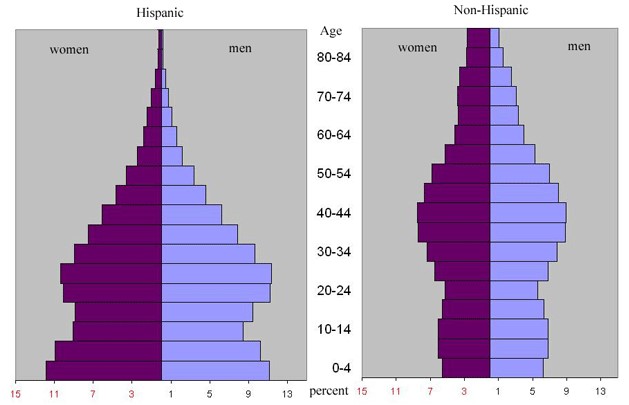Immigration and Chicago’s Growth
In preparing for a presentation to be delivered before the ARS National Forum on Regional Stewardship this week, I was prepared to expound on the superior economic performance of Chicago in comparison to neighboring cities. After all, John Grimond’s recent review of Chicago for Economist magazine recently stated that “Chicago has come through deindustrialization looking shiny and confident.” I must admit that I, too, often characterize Chicago’s performance as robust, and I have observed that both Chicagoans and other Midwesterners believe this to be the case. Much to my surprise, however, in examining total payroll employment trends, I discovered that Chicago’s growth fell short of the neighboring East North Central (U.S. Census division) states region during the 1990s and since that time as well! And in comparison to the nation, Chicago’s per capita income has been flat to slightly declining. What gives?
I believe that part of the answer can be explained by the robust influx of immigrants to the Chicago area, along with the high birth rates of recent immigrants, which have made for a more complex story than the payroll employment and income trends suggest.
Owing to immigration, the Chicago area’s population growth has exceeded the surrounding region since the 1990s, as the chart below suggests. The Chicago metro area is now ranked fifth nationally in proportion of foreign-born population, adding 537,000 between 1990 and 2000—an expansion by over one-half. As of the 2000 U.S. Census, 17.5% of Chicago’s population were foreign born, many of them young families with children. And so, the rapid expansion of the region’s housing stock, revitalization of many older neighborhoods, and home appreciation have not been simply the figments of imagination or the heady boosterism by residents and observers of the Chicago region.
1. Population — index 1990 = 100

The growing immigrant composition of Chicago’s work force, and the way we measure it, may also explain part of its tepid payroll employment growth. Owing partly to language barriers, immigrants are more likely to be self-employed rather than work for a firm as a “payroll” employee. So too, to some extent, immigrant payroll employment may also tend to be casual or uncounted by government payroll employment surveys. An alternative way to estimate employment is conducted by the U.S. Bureau of Economic Analysis (BEA) which takes some account of self-employed workers. In contrast to payroll employment, trends using BEA data (below) suggest that the Chicago area’s employment growth exceeded the East North Central states of Ohio, Indiana, Michigan, Illinois, and Wisconsin in the early years of this decade, and its performance during the 1990s also converges somewhat with the national average.
2. Total payroll employment

3. Total employment (BEA)

A moment’s reflection on the measurement of per capita income may also shed light on Chicago’s seeming lack of per capita income expansion during this period. Immigrant groups vary greatly by educational attainment. A recent paper prepared by Sapna Gupta prepared for Chicago Metropolis 2020 reports that almost two-thirds of working age adult immigrants to Chicago from India have college degrees versus only 3% to 4% of Mexican immigrants. Yet, Mexicans are the dominant immigrant group to Chicago in recent years. Accordingly, since education increasingly determines wage and salary income in our economy, Chicago’s immigrant influx has tended to pull down average income. Of course, immigrant household income, even of the least educated, is likely much higher for them than it would be had they remained in their home country. Accordingly, the attendant diminishment of average per capita income in Chicago does not really reflect falling standards of living of Chicago residents.
So, too, as illustrated below, the age of Chicago’s immigrant households, especially Hispanics, is much younger than the pre-existing population. This will also tend to diminish per capita income, since immigrant households will tend to have many more members who are too young to be earning income. Figures reported by the U.S. Census do show that the share of the Chicago area’s population younger than 25 years of age is greater than the U.S. for the year 2000. This gap between the area and the nation has widened since 1990. In contrast, the surrounding East North Central region reports an older population share than the nation, a gap which developed during the 1990s.
4. Population by Hispanic Origin, Age, and Gender, Chicago MSA, 2000

The Chicago area has become a different place in many respects over the past 20 years as the foreign-born population has expanded. Not everyone has benefited economically from change, but it is quite likely that, on average, Chicago area households have experienced climbing economic well-being. So, too, Chicago’s economic growth has likely exceeded what it otherwise would have been in the absence of immigration.
While the nation currently debates immigration and southern border reform in the U.S. Congress, Chicago’s primary challenges are of a different order. Many recent immigrants face the typical historic barriers to financial and economic assimilation into the Chicago mainstream: lower beginning levels of income, lesser work force skills, lesser knowledge of customs and procedures, and lower education and school readiness. At a time when much of the Midwest region’s existing population is shifting to Sun Belt locales, many foreign born continue to see opportunity here. To bolster the Chicago economy’s prospects, what actions can Chicago pursue to make the most of these immigrants’ energy, ambitions, ties to their countries of origin, and differing skills and culture?
One arena in which the Chicago area and other immigrant centers has been quite active is in facilitating immigrant access to financial channels. On May 4, the Federal Reserve Bank of Chicago and Brookings Institution issued a major study on enhancing the ability of the foreign born to access financial institutions for savings, wealth building and homeownership, payments transactions, and business creation. The study documents the state and progress of immigrant financial practices and access in the United States, along with many lessons learned from diverse perspectives.








